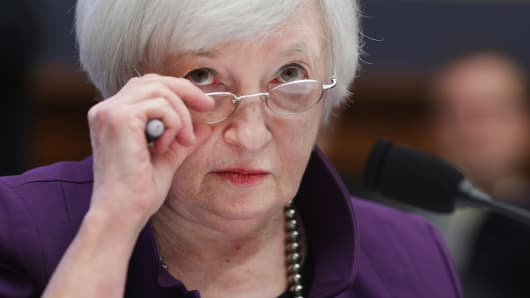on rates until June, following a major selloff in the market Friday morning. The chance of a March hike, above 50 percent just a few days ago, has dwindled to 35 percent.
The next closest month for a hike is now June, which has a 54 percent probability. Earlier in the morning, expectations had put the hike off until July, but that pulled in after New York Fed President William Dudley said in a speech that he still sees rates on a steady trajectory higher.
The decline comes amid a slowing economy, tumbling oil and weakness in Japan. Fed officials, who had indicated in December hopes to raise rates four times in 2016, have been backing off amid the turmoil.
St. Louis Fed President James Bullard said in a speech Thursday morning that the continuing plunge in oil prices could impact the U.S. central bank’s decision-making process. Oil is down nearly 18 percent in January alone, pulling the stock market down with it and causing worries that the U.S. economy will enter a prolonged slowdown. TheS&P 500 is off nearly 8 percent for the month.
The Federal Open Market Committee in December raised the target a quarter-point for the funds rate it uses to influence broader interest rates. It was the first rate hike in more than nine years, and Fed officials indicated they expect four more hikes this year. Under current trading expectations, there is virtually no chance of that happening.
Read More‘Now you know’: Why Fed feared a quarter-point hike
If conditions hold, the opinion from some observers that the Fed will get caught in a “one and done” strategy for hikes would gain credence.
“Low inflation expectations may keep actual inflation lower, all else equal, making it more difficult for the Fed to return inflation to target,” Bullard said.
On Wednesday, Boston Fed President Eric Rosengren said in a speechgrowth appears to be slipping and that could force the Fed into a less aggressive rate-hiking posture. Rosengren and Bullard are voting members of the central bank’s policymaking committee.
Read MoreThe market’s not buying the Fed’s ‘leap of faith’
Finally, Chicago Fed President Charles Evans, a nonvoting member,said Wednesday the Fed probably should consider hiking only two or three times for 2016.
“From my perspective, the costs of raising the federal funds rate too quickly far exceed the costs of removing accommodation too slowly,” Evans said. “So taking both of these concerns into account — and considering how I think economic conditions will evolve over time — I believe that policy should plan to follow an even shallower path for the federal funds rate than currently envisioned by the median FOMC participant.”
The remarks have reverberated through the markets.
“Bottom line, while I so badly want interest rates to be normalized, if current trends in both the economy and markets continue, I don’t see it being realistic that the Fed hikes again and Rosengren and Bullard, both voting members this year, are already showing signs of wobbling in front of the dots,” said Peter Boockvar, chief market analyst at The Lindsey Group.
[“source -cncb”]




